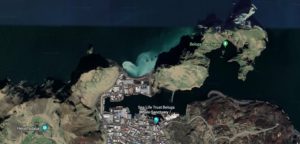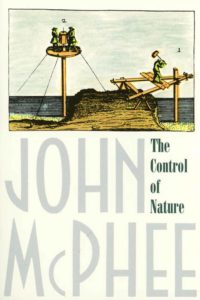
In my last post, I began a review of the book The Control of Nature by John McPhee. I mentioned that the book had three parts, and that I would be doing a review in three parts. See the first part of the review here.
The second part is titled “Cooling the Lava”. This concerns a volcanic eruption in Iceland in February 1973. It’s now been over a month since I read this section (maybe closer to two months), and I don’t remember all the names involved. Basically, this was on an island named Vestmannaeyar on the south side of Iceland. It included a sizable town, an important port, and a valuable fishing fleet and the infrastructure to support this. The town was Heimaey. The volcano was a new one, coming up from nothing but the hot works below the nation’s surface. See the photo I clipped from Google Earth.
Almost from the minute the volcano appeared, the fire boats, engines, hoses, and water came out and people directed it onto the flowing lava. People in the country laughed at them. But as the lava increased, so did the hoses and water. The laughter faded away and fear came.

Many people fled Heimaey. Others came and joined the fire brigade. Slowly, the hose holders won the battle. The lava hardened at the surface and new lava, when it came, piled up higher and higher, but ceased to move forward. The harbor was saved. In fact, the harbor entrance width was cut in half, reducing wave intrusion from the sea but leaving plenty of space for ships and boats to get in and out.
McPhee does a good job of explaining what was done, how the lava behaved, and the aftermath. I especially enjoyed the later. The surface cooled enough to walk on, but stick a thermometer through the surface, and a few inches down you have temperatures that will boil water. The crust, though hard enough to walk on, is thin. This is true even years after the eruption.
My main complaint about this section of the book is the same as the first section: it was too long. McPhee went on and on. He shifted from Iceland to Hawaii, where they took the opposite tack from Iceland. They let the lava flow and hoped for the best. It was interesting to learn about the difference in approaches, but it really dragged out this section. Actually, the Hawaii part wasn’t too long. It was the Iceland portion. I don’t know what I would cut out, but something really needed to be cut.
This makes two parts of the book with the same opinion on quality. Stay tuned for the third part, and my overall conclusion. I’m not sure whether that will be on Monday, or perhaps later.